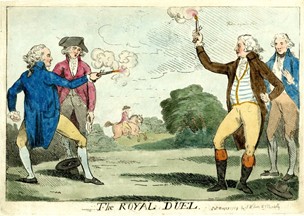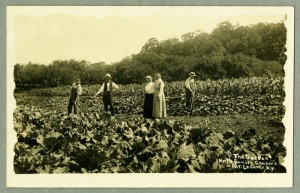To honour Richmond’s 200th anniversary, we will be posting factoids about our rich history. Over the next year you should expect to see 200 pieces of information that you may or may not have already known. The topics included in this post are: #11. Street names #12. Maria Hill at war #13. More street names #14. Maria Hill in Richmond #15. Seeds and crops
If you have a question about the source of a factoid please contact us.
Factoid # 11. If Charles Lennox, the Fourth Duke of Richmond and Governor-General of Canada had looked at the plan drawn by Joseph Fortune, the Duke would have encountered several streets which carried the name of his family, an aide, an old adversary, and a new acquaintance. Charles was not only the Duke of Richmond but also the Duke of LENNOX. Lennox was in fact the surname used by his family members.
The Duke’s daughter Lady Sarah Lennox had eloped with Sir Peregrine MAITLAND. The Duke of Richmond was initially very opposed to this marriage as he did not think that Maitland was a suitable husband for his daughter. The two men eventually reconciled. When Richmond came to Canada to be Governor-General, Maitland and Sarah arrived on the same ship and Maitland assumed the post of Lieutenant-Governor of Upper Canada.
Among those accompanying the Duke on his journey from Perth to Richmond, was his aide, Col. Francis COCKBURN, Deputy-Quarter-Master-General. Cockburn had initiated the creation of the Richmond Settlement, was overseeing its development and in 1822 would recommend withdrawal of military funding.

#1868,0808.5860
The Duke visited Richmond on his return from YORK (Toronto), which was named after the Duke of York, the second son of King George III. In 1789, the Duke of York had questioned the bravery of the Lennox family; Charles Lennox challenged him to a duel, and the two met on Wimbledon Common. A bullet from Lennox’s pistol grazed York’s ‘false curl’ but no injury resulted.
While in York, the Duke would have encountered the most dominant religious figure in the colony, the Anglican priest John STRACHAN, a member of the Executive Council and staunch supporter of the monarchy.
Thus we know the significance of five Richmond street names: Lennox, Maitland, Cockburn, York and Strachan. These 5 names were familiar to Superintendent Col. BURKE. The surveyor, Joseph FORTUNE, who compiled the 1818 plan, and Burke also had streets which carry their names.
Factoid #12. Except for Laura Secord, we know very little about the role played by Canadian women in the War of 1812, and even less about their role in the early years of the Richmond Settlement. The exception is Maria Hill, wife of Sgt. Andrew Hill of the 100th Regiment of Foot. She was a true heroine in both settings. Having spent much of her life living in army barracks, Maria was one of the wives who routinely accompanied the troops as they traveled across Upper Canada. She cooked and cleaned for them and nursed their wounds on the battlefield. John Curry, Kurt Johnson and the researchers at the Goulbourn Museum have been investigating Maria’s actions and tried to separate fact from fiction. You may find more information in their writing.
At a time when she could have been safely living in barracks with the other women and children, Maria was trudging around the Niagara Peninsula. Amid the chaos, bloodbath and heartbreak of the battlefield she assisted the surgeons and helped care for the wounded and bodies of the dead. The 100th Regiment experienced victories like the capture of Fort Niagara but also defeats, non greater than the Battle of Chippawa. At Chippawa the British force was out manned 2000 to 3500 by the Americans. Casualties were high. In her old age, Walter Shanly recorded how she remembered the fate of the leaders. “With graphic energy she described the scene in the hospital tent, and the carrying in, in rapid succession of bleeding soldiers. She called over the names of officers whose wounds she helped to bandage, and told of the terrible cutting up of her own regiment in particular; poor young lieutenant Fortune carried in dead; colonel Hamilton, seriously hurt, captain Sleigh, badly wounded, and so on.” Maria also said that she would never forget the evacuation from the Niagara frontier. “The wounded who could be moved, the invalids, and the women were sent to Cornwall…. She described the sufferings endured, the dragging and jolting of the waggons; the guard marching sometimes ankle deep in mud for weary days and nights around Burlington Heights, and so on, on, and on along the shore of lake Ontario, until at last Cornwall was reached late at night.” From his interview in 1881, Shanly wrote that Maria was “always with the army” and in her own words she was a “soldier all through”. Her bravery was indeed equal to her loyalty.
Factoid # 13. From Factoid 12 we see the origins of more Richmond street names. FOWLER got its name from Lieut. Fowler killed at the Battle of Chippawa and HAMILTON was called after Col. Christopher Hamilton wounded in the same battle.
The War of 1812 also provided other heroes who were honoured by the military when streets were named. FORTUNE St, as stated in an earlier factoid, may have been named after Joseph Fortune, the man who surveyed the village, but the name would have been given added importance because of Ensign Francis Rawdon Fortune who was wounded at the Battle of Chippawa, taken prisoner and died later at Buffalo.
MURRAY was named after Col. John Murray who led the 100th in the Raid on Plattsburg in July 1813, as well as the capture of Fort Niagara in December of that year. Murray was slightly wounded at Niagara.
MARTIN Street got its name from Major John Martin who was named in dispatches after the capture of Fort Niagara and also fought at the Battle of Chippawa.
MCBEAN was called after Lieutenant-Colonel McBean.
None of these officers actually settled in Richmond although their names were embedded in the memories of Joseph Fortune and Col. Burke as they compiled the plan for the village.
Factoid #14. Maria Hill was a legendary figure not only in wartime but also peace. It’s difficult to know if one is presenting a true picture of her character and importance because all the writings portray her as a romantic heroine. Here is a synopsis of the assertions of her role in Richmond.
A very energetic woman she worked hard to build a successful business but at the same time she was ready to help her fellow settlers. It is said that she felt (probably correctly) that she and Andrew were not cut out to be farmers. Andrew was in a position to provide the resources to start a tavern. He not only had his pension but also worked as a clerk in the commissary. The soldiers in the village were used to having him dispense their daily beer rations (one of the duties of an army sergeant) and so this activity could be transferred to civilian life. Maria had him expand their house and make room so that they could run a hotel. She was known as being a great hostess, an outstanding cook and a woman who loved to sing and lead her clients in song. She loved the soldiers and they loved her. Probably more important she was trusted by the officer leaders of the community. When the Duke of Richmond visited in 1819, Maria was asked to house him and provide the banquet for his entertainment. The military provided the supplies she needed to make his stay as comfortable as possible. After his death, her experience on the battlefield was called upon to prepare his body for transportation to Quebec City.
It seems that in a village of hardworking people her establishment became the centre of lighthearted social life. Early maps and accounts indicate that the hotel was indeed located in the middle of the village, on the south side of Strachan Street just west of McBean. Although regular church services were held in the schoolhouse, at least one wedding took place at the hotel. When it was first built it was called the Masonic Arms and the local Masons met there. After the Duke’s visit the name was changed to the (Duke of) Richmond Arms. Soldier/settlers, civilians and even the officer’s mess met at the hotel.
Maria was the person the population could count on when they needed medical help. Although the village had a doctor, there are references to people asking for her assistance. She was loyal to her people and they to her. Her life changed drastically in 1830 when Andrew died but she continued to be a force in the village for the next 50 years.
Factoid #15. The first priority in building a successful long-term settlement was to establish a vibrant farming community. We are told that the military gave the soldiers a selection of seeds. They and civilian settlers, as well as the officers, could also buy seeds from Philemon Wright or the Montreal merchants. Non-soldier settlers often brought seeds with them from the old country.
An article in the Montreal Gazette of 30 January 1822 touted the success of Andrews Lett. The article reads as an attempt to encourage prospective settlers to come to the village. Lett had only been in the village since the fall of 1820 when the article appeared. ” In the village of Richmond, Upper Canada, from one one and a quarter (1 ¼) acres of new land cleared by Capt. Lett of the half pay of the 26th (Regiment) the following crop was gathered last season. 400 Bushels of Potatoes, 3 and half Bushels of Peas, 3 and a half do. (Bushels) Beans, 23 (Bushels) Carrots, 3 (Bushels) Parsnips, 12 (Bushels) Turnips, 19 (Bushels) Corn, 1500 heads of Cabbage, 250 Squashes and Pumpkins.” Keep in mind that Lett was able to do this because he had been given excellent land: the 20 acres stretching southeast from the intersection of King St. and Perth St. He also had the resources to pay for extra labour and equipment.

Another officer, Capt. George Lyon, is known to have purchased seeds as well as plants and fruit trees from one of his Montreal suppliers. Although most of his orders were small, in 1823 Lyon ordered a total of 45 plants and 62 trees. You can read an article about his purchases at a previous post, “Seeds for the Future – Gardening in the 1820’s”. Most interesting to me was his acquisition of a “Shaker Sampler”. This was a box of a variety of seeds from the Cooperative that was known throughout America not only for its agricultural prowess but also its superior line of furniture. (This celibate fundamentalist Christian group is an interesting investigation in its own right.)
But what of the solitary settlers toiling on questionable land and with few extra resources? We have not uncovered any accounts to show the level of their success.

One Response to Richmond 200 – Factoids #11 – #15